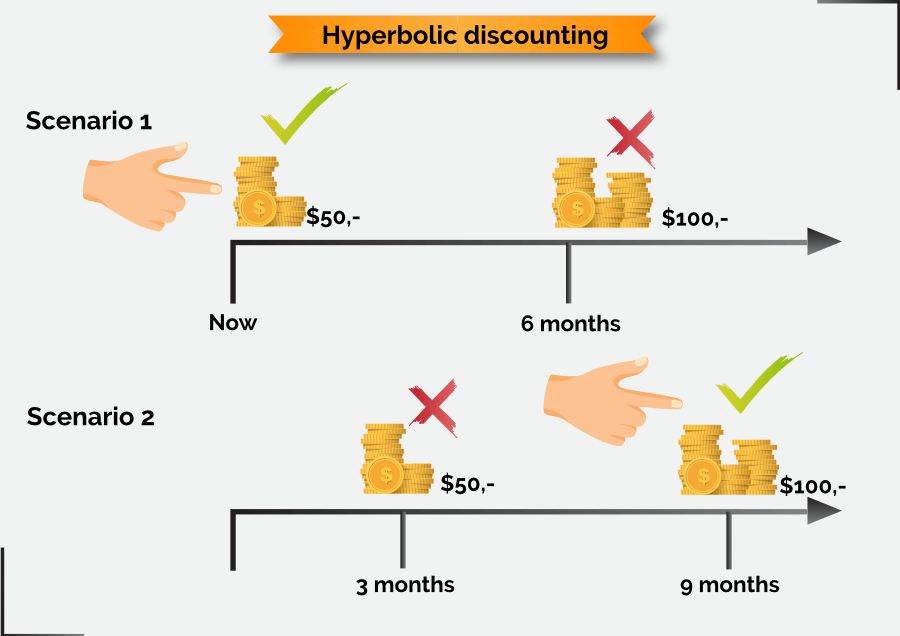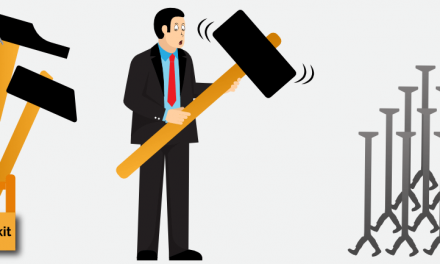There are always pressing matters that impede longer term opportunities and chances. There is so much to do and you know you should work on some longer term tasks, but every time you seem to get near starting one, something more urgent pops up. You promise yourself that once this urgent matter is dealt with you will absolutely take on this task you know will be very important later. But then the next urgent issue pops up. Does this sound familiar? The feeling of being preoccupied with urgent matters can overwhelm and be frustrating. I can feel like a burden. In this article we explore why this happens and how you can escape the tyranny of the urgent.
What can you expect from this article?
- Why do we get so preoccupied with urgent matters?
- How can you escape from this?
Why do we get so preoccupied with the urgent?
We have a bias towards the short-term
Hyperbolic Discounting
We even have a fancy name for this phenomenon. It is called Hyperbolic Discounting. Hyperbolic Discounting is a mental bias where people tend to choose smaller rewards now over larger rewards later. They put a discount on the value of a later reward. We rather take $50,- now than $100,- a month from now. Believe me, this has been tested.
The effect is hyperbolic because the effect diminishes after a longer delay. If we are given the choice $50,- in three months or $100,- in nine months we would probably wait for the $100. That’s weird isn’t it? Its the same amounts of money and the same separation in time, we just shifted everything three months in time.
This explains why we go for the immediate ‘reward’ of finishing the urgent job over the later reward of the longer-term job. Even is the long-term job is more important. The Hyperbolic Discounting effect can be very strong and what’s worse: we’re often not aware of it. It is not rational behavior, however we all think we are rational beings in our decision making.
Being so occupied with short term ‘running the business’ tasks can be a burden. It clouds your ability as a business leader to really think about the future. But if you as a business leader fall into the trap of the tyranny of the urgent, it is no wonder the rest of your organization does so too. Do you ever experience the feeling that everyone in your organization, department, or team is always busy, busy, busy, but as a whole we seem to move nowhere? This is lethal in today’s world of fast change. It is easy to envision how an entire organization can be so busy with seemingly urgent short-term issues it forgets to work on its future until someone else has decided the future for you. The competition that is. However paradoxical it might sound: we don’t have time to keep preoccupied with the ‘now’. It is time to get busy with the ‘later’.
We don’t have time to keep preoccupied with the ‘now’. It is time to get busy with the ‘later’.
How to escape the Tyranny of the Urgent?
It all starts with realizing you have a choice. It is easy to say to yourself you really don’t have a choice but to attend to the urgent matters first. But if you don’t give yourself a choice, you will never break free from this burden. It is important to realize that just because a task feels urgent it doesn’t mean it is important. A sense of urgency is an emotion, fueled by hyperbolic discounting. Because the effect of the task is short-term, it feels important. The reward is within reach, or the danger is eminent. A customer complaint or a sudden market development feels important because you can almost feel the negative effect if you don’t turn your attention towards it immediately. But the result might be you keep chasing ‘the now’ and keep stuck in execution mode, and never get to tasks that contribute to fulfilling your vision. Even though in the back of your mind you know that not attending to the future poses an even bigger risk.
Pre-commitment
The trick to escape the hyperbolic discounting effect is something called pre-commitment: you embed future results in current decisions. Lakshmi Mani: Pre-commitment is a way to lock future you into decisions, now. You increase your chance of success by removing temptation from future you.1 She continues with the example of subscription meal services. You commit, and pay, for a service that delivers a healthy meal next week. This increases the chance that you will eat healthy next week, instead of falling for the short-term rewarding temptation of junk food.
Use an economic decision framework
What do I mean with that? We are all busy. So we have to make choices all the time on what to do next and what to postpone until later. But it is important to make choices consciously and use some kind of decision framework for our choices. If we don’t, we will always listen to that inner voice that tells us this one thing takes precedence because it is urgent. We are intrinsically biased towards the short term and will therefore always choose urgent short-term jobs over longer term jobs, even if the longer term jobs can provide more value, unless we consciously base our choices on a richer decision framework that takes more factors into account. The decision framework ensures we commit to future events in our current decisions.
A decision framework sounds complicated and big. But it doesn’t have to be. The most important step is you make prioritizing a conscious process in which you realize there will always be more urgent matters, until you yourself decide that urgency is not the only factor that determines what to do next. Urgency or time-criticality is a factor to take into account for sure. But so is value. The trick is not to look at a task in isolation but to compare it to others using criteria such as time-criticality and value. Pursuing a task just because it is urgent is really not prioritizing at all. You can only prioritize if you compare one task to another. This allows you to consciously say “Well, this task feels urgent, but that task actually provides more value”. That doesn’t guarantee you won’t pursue the urgent task nor should it, but at the very least you make a conscious choice.
So how do you embed future results in current decisions? By comparing long-term value to short-term value instead of just giving in to the emotion of urgency. So every time you are inclined to pay attention to a task that feels urgent you ask yourself: “Is there something else I could do instead that provides more value in the long run?” Force yourself not to pickup the first task that comes on your path because it is urgent, but compare it to other things you could do in that time. Which one is more valuable?
Use pre-commitment buckets
A more explicit way of pre-commitment is to create task buckets and pre-commit a certain amount of time to each. You could for example have a bucket labeled ‘urgent’ and a bucket called ‘vision’. You commit to spending only two hours a day on tasks from the urgent bucket. Maybe the first two hours of the day. It might feel liberating to spend the start of the day on getting rid of some urgent matters, but then turn your attention to building your business.
The term ‘buckets’ is meant quite literally. It could be digital buckets like folders in your email client. You could also use a tool like One Note or Evernote to capture al items that need you attention and label them. Or use one of the many tools that support ‘Getting Things Done’. But especially when your start, an non-digital form might work better. Just use something like trays.
What is important is, that you get all the tasks out of your head, and into the buckets. Preferably in a very visual way. That unlocks the potential to consciously prioritize. Remember, your mind plays irrational tricks with you, biasing short-term things. So get the tasks out of your mind.
Build a system that works for you. It is highly personal. A bucket I would like to recommend however is ‘learning’. This could include books, blogs, podcasts, (online) courses, seminars, or peer groups. Lifelong learning is crucial for modern leaders and managers but the tyranny of the urgent can easily stand in the way of learning. The beauty of learning is that its is an activity that can well be done outside of the office which make committing to it a lot easier. Th only thing you have to do to make sure you will not be disturbed is to turn your phone off. That might feel intimidating but if you really have to worry that your company will burn to the ground in your absence, you have some serious changes to make in your management style anyway.
From present-forward to future-backwards mode
The dominant decision-making management style in organizations is locked into the presence. Decisions are based on today’s and yesterday’s weather. We tend to pursue or not pursue an opportunity based on our current ability rather than our future need. “We tried something like this already. Didn’t work then. Won’t work now”. “That will never work here”. “That is not the business we are in”. “We cannot invest people or resources into that future thingy, we need to make money now”. We drag the past with us, keeping us at our place, maneuvering in the short-term, making it hard to work on the future. Politics, past failures and successes, dramatic events, short-term targets… they all influence our ability to liberate ourselves from the present.
To escape the tyranny of the urgent, we must move from a present-forward mode to a future-backwards mode. Start with your vision of the future and then work backwards to find out which decisions you need to make and which tasks to work on. Again, this ensures that future results are embedded in today’s decisions. This prevents an overly focus on short-term tasks. It also ensures the reach of decisions is not limited by current reality..
Conclusion
Staying preoccupied with short-term urgent matters goes at the expense of longer-term tasks that are equally or even more important. Not only can it feel like a burden, it is also dangerous for the continuation of the company. Especially nowadays when changes move so fast.
Luckily we are not delivered to the mercy of the tyranny of the urgent. We can escape from it. Pre-commitment, economic prioritizing, pre-commitment buckets, and a future-backwards mode all help.
Follow this article
You can choose to follow this article in which case you will be notified when there there are updates of the article. You can also choose to follow all articles of this category. You will then be notified if a new article is added in this category.
Click here to see all the content you are following.
Bibliography
List of notes and sources we reference from.
Notes
- Lakshmi Mani. Hyperbolic discounting: Why you make terrible life choices. https://medium.com/behavior-design/hyperbolic-discounting-aefb7acec46







